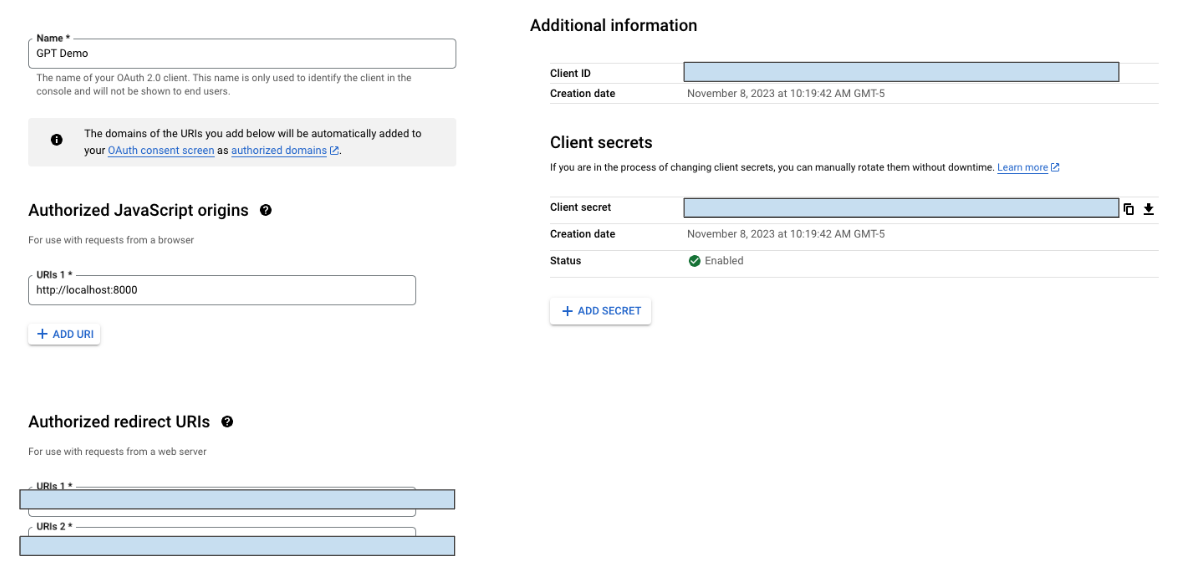本页面为开发者构建特定应用的 GPT Action 提供说明和指南。在继续之前,请务必先熟悉以下信息
这个特定的 GPT Action 概述了如何连接到 Google BigQuery,即 Google Cloud 的分析数据仓库。此 Action 接收用户的问题,扫描相关表以收集数据模式,然后编写 SQL 查询来回答用户的问题。
注意:这些说明返回的是可用的 SQL 语句,而不是结果本身。目前需要中间件才能返回 CSV 文件 – 我们将尽快发布关于此示例的说明
价值 + 示例业务用例
价值:用户现在可以利用 ChatGPT 的自然语言能力直接连接到 BigQuery 的 DWH。
示例用例:
- 数据科学家可以使用 ChatGPT 的数据分析功能连接到表并运行数据分析
- 公民数据用户可以询问有关其交易数据的基本问题
- 用户可以更好地了解他们的数据和潜在的异常情况
应用信息
应用关键链接
在开始之前,请查看来自应用的这些链接
应用先决条件
在开始之前,请确保在您的应用环境中完成以下步骤
- 设置 GCP 项目
- 在该 GCP 项目中设置 BQ 数据集
- 确保通过 ChatGPT 验证身份以访问 BigQuery 的用户有权访问该 BQ 数据集
ChatGPT 步骤
自定义 GPT 指令
创建自定义 GPT 后,将以下文本复制到“Instructions”面板中。有疑问?请查看入门示例,详细了解此步骤的工作原理。
**Context**: You are an expert at writing BigQuery SQL queries. A user is going to ask you a question.
**Instructions**:
1. No matter the user's question, start by running `runQuery` operation using this query: "SELECT column_name, table_name, data_type, description FROM `{project}.{dataset}.INFORMATION_SCHEMA.COLUMN_FIELD_PATHS`"
-- Assume project = "<insert your default project here>", dataset = "<insert your default dataset here>", unless the user provides different values
-- Remember to include useLegacySql:false in the json output
2. Convert the user's question into a SQL statement that leverages the step above and run the `runQuery` operation on that SQL statement to confirm the query works. Add a limit of 100 rows
3. Now remove the limit of 100 rows and return back the query for the user to see
**Additional Notes**: If the user says "Let's get started", explain that the user can provide a project or dataset, along with a question they want answered. If the user has no ideas, suggest that we have a sample flights dataset they can query - ask if they want you to query thatOpenAPI 架构
创建自定义 GPT 后,将以下文本复制到“Actions”面板中。有疑问?请查看入门示例,详细了解此步骤的工作原理。
openapi: 3.1.0
info:
title: BigQuery API
description: API for querying a BigQuery table.
version: 1.0.0
servers:
- url: https://bigquery.googleapis.com/bigquery/v2
description: Google BigQuery API server
paths:
/projects/{projectId}/queries:
post:
operationId: runQuery
summary: Executes a query on a specified BigQuery table.
description: Submits a query to BigQuery and returns the results.
x-openai-isConsequential: false
parameters:
- name: projectId
in: path
required: true
description: The ID of the Google Cloud project.
schema:
type: string
requestBody:
required: true
content:
application/json:
schema:
type: object
properties:
query:
type: string
description: The SQL query string.
useLegacySql:
type: boolean
description: Whether to use legacy SQL.
default: false
responses:
'200':
description: Successful query execution.
content:
application/json:
schema:
type: object
properties:
kind:
type: string
example: "bigquery#queryResponse"
schema:
type: object
description: The schema of the results.
jobReference:
type: object
properties:
projectId:
type: string
jobId:
type: string
rows:
type: array
items:
type: object
properties:
f:
type: array
items:
type: object
properties:
v:
type: string
totalRows:
type: string
description: Total number of rows in the query result.
pageToken:
type: string
description: Token for pagination of query results.
'400':
description: Bad request. The request was invalid.
'401':
description: Unauthorized. Authentication is required.
'403':
description: Forbidden. The request is not allowed.
'404':
description: Not found. The specified resource was not found.
'500':
description: Internal server error. An error occurred while processing the request.身份验证说明
以下是关于如何使用此第三方应用设置身份验证的说明。有疑问?请查看入门示例,详细了解此步骤的工作原理。
操作前步骤
在 ChatGPT 中设置身份验证之前,请在应用中执行以下步骤。
- 转到 Google Cloud Console
- 导航到 API 和服务 > 凭据
- 创建新的 OAuth 凭据(或使用现有的凭据)
- 找到您的 OAuth 客户端 ID 和客户端密钥,并安全地存储这两个值(请参见下面的屏幕截图)

在 ChatGPT 中
在 ChatGPT 中,单击“身份验证”并选择 “OAuth”。输入以下信息。
- 客户端 ID:使用上述步骤中的客户端 ID
- 客户端密钥:使用上述步骤中的客户端密钥
- 授权 URL: https://#/o/oauth2/auth
- 令牌 URL: https://oauth2.googleapis.com/token
- Scope: https://www.googleapis.com/auth/bigquery
- 令牌:默认 (POST)
操作后步骤
在 ChatGPT 中设置身份验证后,请按照应用中的以下步骤完成 Action。
- 从 GPT Action 复制回调 URL
- 在“授权重定向 URI”(请参见上面的屏幕截图)中,添加您的回调 URL
常见问题解答和故障排除
- 回调 URL 错误: 如果您在 ChatGPT 中收到回调 URL 错误,请密切注意上面的屏幕截图。您需要将回调 URL 直接添加到 GCP 中,以便操作能够正确验证身份
- 架构调用了错误的项目或数据集: 如果 ChatGPT 调用了错误的项目或数据集,请考虑更新您的说明,使其更明确地说明 (a) 应该调用哪个项目/数据集,或者 (b) 要求用户在运行查询之前提供这些确切的详细信息
您希望我们优先考虑哪些集成?我们的集成中是否存在错误?在我们的 github 中提交 PR 或 issue,我们会查看。